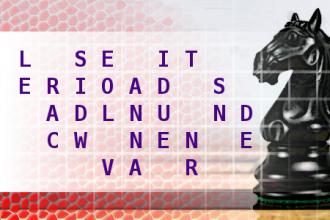Chess Knight Move
Find the title of novel, using the move of a chess knight. First letter is A. Length of words in solution: 6,10,2,10.Correct answers: 22
The first user who solved this task is Alfa Omega.
#brainteasers #wordpuzzles #chessknightmove

A sad-faced Doug walked into a...
A sad-faced Doug walked into a flower shop early one morning.
The clerk was ready to take his order for a funeral piece, based on the look on Doug's face, but soon realized his assumption was wrong as Doug asked for a basket of flowers sent to his wife for their anniversary.
"And what day will that be?" the clerk asked.
Glumly he replied, "Yesterday".
The clerk was ready to take his order for a funeral piece, based on the look on Doug's face, but soon realized his assumption was wrong as Doug asked for a basket of flowers sent to his wife for their anniversary.
"And what day will that be?" the clerk asked.
Glumly he replied, "Yesterday".

